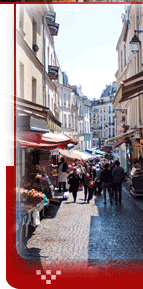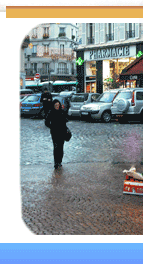Rue Mouffetard
Your Complete Guide to Paris's Historic Market Street
Literary Paris Walking Tour 2025: Hemingway, Joyce & Hugo in the Latin Quarter

The Latin Quarter pulses with literary history at every cobblestoned turn. From Rue Mouffetard's ancient market street to the hallowed halls where Nobel laureates wrote their masterpieces, this comprehensive walking tour reveals the interconnected world of three literary giants: Ernest Hemingway, James Joyce, and Victor Hugo. Follow in their footsteps through a neighborhood where words changed the world.
📍 Tour Essentials
Duration: 3-4 hours (full day with museum visits)
Distance: 3.5 kilometers (2.2 miles)
Best Times: Tuesday-Thursday 9 AM-12 PM or 3-6 PM
Starting Point: Place de la Contrescarpe (Metro: Cardinal Lemoine)
Difficulty: Easy walking, some stairs at viewpoints
Stop 1: Place de la Contrescarpe - Literary Crossroads
Begin where three literary worlds converge. This intimate square, unchanged since the 1920s, witnessed both Ernest Hemingway and James Joyce as neighbors, living just streets apart while creating works that would define modern literature. The medieval charm that captivated Hugo in the 19th century remains remarkably intact.
🏛️ Historical Context
Place de la Contrescarpe sits atop the ancient Roman road that became Rue Mouffetard. Hugo called this area "the beating heart of old Paris," while Hemingway described it as the perfect starting point for exploring authentic Parisian life away from tourist crowds.
Café Delmas (Current): The descendant of Café des Amateurs, which Hemingway famously described as "the cesspool of the rue Mouffetard" but frequented nonetheless. Today's Café Delmas maintains the authentic neighborhood atmosphere that drew writers seeking genuine Parisian café culture.
Stop 2: 74 Rue du Cardinal Lemoine - Hemingway's First Paris Home
Walk down the gentle slope of Rue du Cardinal Lemoine to number 74, where Ernest Hemingway lived from January 1922 to August 1923. This modest third-floor apartment, with no hot water and a shared toilet, became the birthplace of his distinctive style and his memoir "A Moveable Feast."
💰 Literary Economics: Hemingway paid 250 francs per month (about $20 USD then) for the apartment. The building now features a commemorative plaque, and similar apartments recently sold for over €1 million—a testament to the neighborhood's literary prestige.
Key Quote: "Paris was always worth it and you received return for whatever you brought to it. But this is how Paris was in the early days when we were very poor and very happy."
Stop 3: 71 Rue du Cardinal Lemoine - Joyce's Literary Laboratory
Just three doors down, at number 71, James Joyce lived in French poet Valery Larbaud's apartment during 1921. Here, Joyce made the final revisions to "Ulysses," the novel that would revolutionize modern literature. The proximity to Hemingway's residence created an extraordinary literary concentration on this single street.
Stop 4: 39 Rue Descartes - Hemingway's Writing Sanctuary
Climb the narrow stairs of this building where Hemingway rented a separate room solely for writing. The top-floor space, where Paul Verlaine died in 1896, became Hemingway's creative sanctuary. Here he would bring wood for fires and write about "the good place" while developing the clean, understated prose that earned him the Nobel Prize.
Literary Technique: "I had learned already never to empty the well of my writing; but always to stop when there was still something there in the deep part of the well, and let it refill at night from the spring that fed it."
Stop 5: Shakespeare and Company Sites - Literary Publishing Revolution
Original Location: 12 Rue de l'Odéon
Walk to the original Shakespeare and Company, now marked by a plaque commemorating the publication of "Ulysses." Sylvia Beach's bookshop served as Joyce's unofficial office and the center of Anglo-American literary culture. Joyce nicknamed it "Stratford-on-Odéon" and used it daily for correspondence and meetings.
Current Location: 37 Rue de la Bûcherie
The modern Shakespeare and Company, across from Notre Dame, continues the literary tradition. Since 1951, it has hosted Beat Generation writers and maintains guest beds for traveling writers—over 40,000 people have slept among the books over the decades.
Stop 6: Notre Dame Cathedral - Hugo's Architectural Salvation

Victor Hugo didn't just write about Notre Dame—he saved it. In 1829, the cathedral faced demolition due to neglect and damage. Hugo's novel "Notre-Dame de Paris" (The Hunchback of Notre Dame) awakened public consciousness and funded the massive restoration that preserved this Gothic masterpiece for future generations.
🏗️ Hugo's Preservation Legacy
Literary Activism: Hugo's novel raised both awareness and funds for Notre Dame's restoration. Published in 1831, it transformed public opinion about Gothic architecture from "barbaric" to "magnificent." The restoration took 23 years, completing just as Hugo's literary reputation reached its zenith.
Stop 7: 6 Place des Vosges - Maison de Victor Hugo
In one of Paris's most beautiful squares, Hugo lived from 1832 to 1848 in what is now the Maison de Victor Hugo museum. Here he completed "The Hunchback of Notre Dame," entertained Balzac and Lamartine, and designed unique interiors influenced by Chinese and Japanese art—a remarkable fusion that predated European interest in Asian aesthetics.
🎨 Museum Highlights
- Writing Desk: Original furniture where Hugo wrote many masterpieces
- Personal Drawings: Hugo's artistic works, praised by Van Gogh as "astonishing things"
- Memorial Room: Dedicated to his daughter Léopoldine, featuring the heart-wrenching poem "Tomorrow at Day Break"
- Oriental Rooms: Hugo's innovative interior design blending Eastern and Western aesthetics
Stop 8: Saint-Germain Literary Cafés - The Writer's Office
Les Deux Magots (6 Place Saint-Germain-des-Prés)
Hemingway used this café as a setting in "The Sun Also Rises." The awning that read "Aux Deux Magots" in the 1920s welcomed Joyce, Picasso, and Camus. Today it remains a tourist destination, but the literary atmosphere persists, especially on the first floor.
Café de Flore (172 Boulevard Saint-Germain)
The famous stove around which penniless writers gathered for warmth still anchors this café where Hemingway wrote regularly. Later, Sartre and de Beauvoir developed existentialist philosophy at these tables, declaring "at this Café, we were at home."
Brasserie Lipp (151 Boulevard Saint-Germain)
Hemingway's favorite for "beer and sausages with pommes à l'huile." His description captures the sensory appeal: "The beer was very cold and wonderful to drink. The pommes à l'huile were firm and marinated and the olive oil delicious."
Stop 9: Panthéon - Literary Immortality
The literary pilgrimage concludes where Hugo rests alongside France's greatest minds. Built as a church to Saint Genevieve, the Panthéon became a secular mausoleum honoring distinguished citizens. Hugo shares the crypt with Voltaire, Émile Zola, and Alexandre Dumas—France's ultimate literary gathering.
🎭 Hugo's Final Triumph
National Mourning: When Hugo died on May 22, 1885, over 2 million people attended his funeral procession from Arc de Triomphe to the Panthéon. The Arc was draped in black, and the entire nation mourned. His final words, "To love is to act," became a national motto.
Hidden Gems & Insider Tips
🔍 Literary Detective Work
- Arenes de Lutece: Visit the hidden Roman amphitheater that Hugo helped preserve—now a peaceful park where locals play pétanque
- Jardin des Plantes: Walk the paths where Hugo composed poetry while strolling with grandchildren Georges and Jeanne
- Le Grand Véfour: Dine where Hugo always ordered vermicelli with mutton and white beans (now Michelin-starred, reservations essential)
- Saint-Sulpice Church: See where Hugo married Adèle Foucher and admire Delacroix murals that inspired "Les Misérables"
Literary Quotes from Each Location
Practical Planning Information
🗓️ Opening Hours & Access
- Maison de Victor Hugo: Tuesday-Sunday 10 AM-6 PM (free admission)
- Shakespeare and Company: Daily 10 AM-10 PM (browsing free)
- Panthéon: Daily 10 AM-6:30 PM (admission required)
- Notre Dame: Check restoration status and current access
- Literary Cafés: Daily, typically 7 AM-2 AM
🎯 Photography & Timing Tips
- Golden Hour: 6-7 PM for dramatic building facades and atmospheric street scenes
- Avoid Crowds: Tuesday-Thursday mornings for Place des Vosges and major sites
- Literary Atmosphere: Visit cafés during off-peak hours (3-5 PM) for authentic writer ambiance
- Market Days: Wednesday, Friday, Sunday on Rue Mouffetard for authentic market street photography
Transportation & Route Optimization
Metro Connections:
- Cardinal Lemoine (Line 10): Start point for Hemingway/Joyce locations
- Saint-Paul (Line 1): Place des Vosges and Hugo museum
- Saint-Germain-des-Prés (Line 4): Literary cafés district
- Cardinal Lemoine or Cluny-La Sorbonne: Panthéon access
Walking Route Optimization: The tour can be completed as a logical loop, starting at Place de la Contrescarpe, moving through the Joyce/Hemingway sites, crossing to Saint-Germain for the café circuit, and ending at the Panthéon. Allow extra time for the Hugo museum and Shakespeare and Company browsing.
Literary Legacy & Modern Connections
This walking tour reveals how literature shaped physical Paris and how place shaped literary genius. Hemingway's sparse prose emerged from modest quarters where every word mattered. Joyce's stream-of-consciousness reflected the layered complexity of his historic surroundings. Hugo's social consciousness grew from witnessing inequality in streets he fought to preserve.
Today, the Latin Quarter continues this tradition. New bookshops, literary cafés, and reading series keep the neighborhood's literary DNA alive. Independent publishers, literary magazines, and writing workshops flourish in the same streets where three literary giants redefined what literature could accomplish.
📚 Continue Your Literary Journey
Explore more literary connections in our related guides: